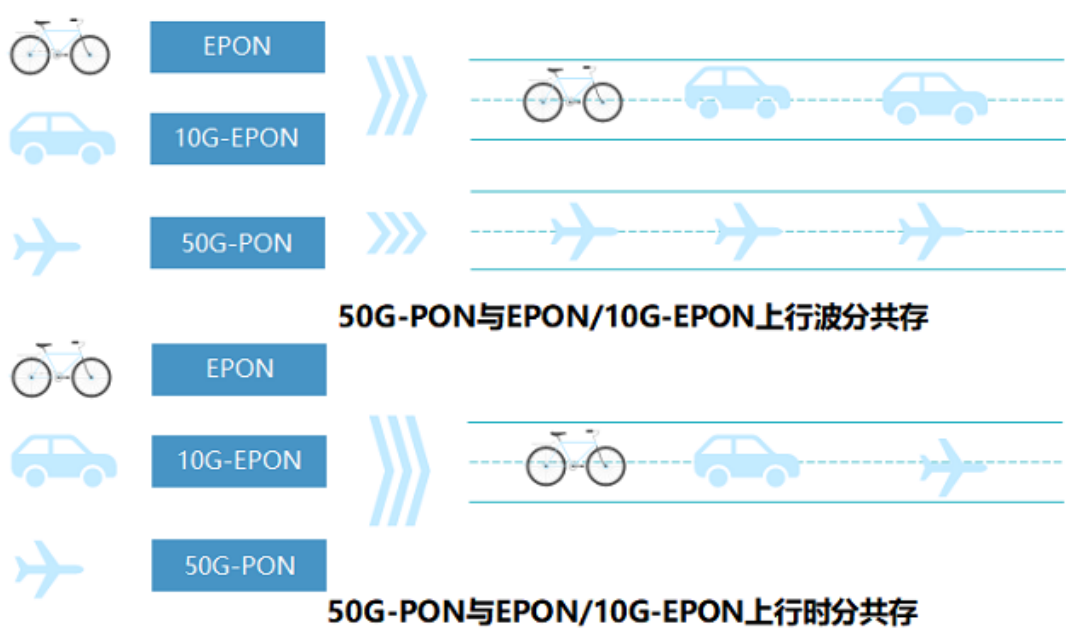2022-03-27 16:34 Source: OFweek Optical Communication Network Article
With the explosion of emerging businesses such as 8K ultra high definition video, cloud gaming, VR teaching, and industrial AOI quality inspection, gigabit broadband can no longer meet users' demand for ultimate experience, and 10G access capability has become the next strategic high ground for operators. As the core of the new generation PON technology, 50G PON has become a key infrastructure supporting computing power networks, smart cities, and AI public services due to its characteristics of ultra large bandwidth and ultra-low latency. However, the evolution from 10G EPON to 50G PON is not a simple rate upgrade. How to achieve efficient coexistence of multiple generations of PON technology in the same fiber has become the primary technical challenge faced by operators.
Wavelength Conflict Challenge: Coexistence Game between EPON and 50G PON
The upstream wavelength range of EPON network is 1260-1360nm, while the upstream wavelength of 50G PON is in the narrow band of 1286nm ± 2nm, with significant overlap between the two. This wavelength conflict forces operators to address two core issues: how to avoid signal interference and how to balance smooth upgrades with network performance.

Figure 1 Upstream wavelength of EPON and 50G PON
In response, a domestic operator has proposed two technical routes:
1. Third generation wavelength division coexistence solution: By narrowing the upstream wavelength of EPON ONU to 1290-1330nm, wavelength division isolation is achieved with GPON and 50G PON. This solution draws on the coexistence experience of GPON and XG (S) - PON, with high technological maturity, and has been validated and commercialized on the existing network.
2. Third generation time-division multiplexing scheme: Assign new wavelengths to 50G PON and use multi rate time-division multiplexing (TDM) for uplink. This solution requires breakthroughs in key technologies such as high-speed signal dynamic scheduling and delay control, and is still in the exploratory stage.

Figure 2 Coexistence Mode of 50G PON and EPON/10G EPON
The hidden worry of time-division multiplexing: the cost of efficiency and latency
The core idea of time-division multiplexing scheme is to schedule EPON, 10G EPON, and 50G PON data to be transmitted on the same channel in a time-sharing manner, and schedule different types of ONUs according to different time windows. However, this design faces two major flaws:
Sudden drop in bandwidth efficiency: The speed difference between EPON and 50G PON is 50 times. When transmitting the same amount of data, EPON will occupy 50 times the time window, resulting in a maximum reduction of about 75% in the available bandwidth of 50G PON.
Delay surge: Under the coexistence of wavelength division, the delay of 50G PON can be controlled at the level of hundreds of microseconds, while time-division multiplexing may cause the delay to soar to the millisecond level, which is a fatal flaw for low latency services such as cloud gaming, remote healthcare, and industrial quality inspection.
Taking Shanghai Telecom's "Dual 10 Gigabit Input" as an example, it has achieved 1-millisecond access to the Lingang Intelligent Computing Center based on 50G PON; The "three-level latency circle" planned by China Mobile (backbone 20ms, provincial 5ms, city 1ms) also relies on low latency PON technology. If time-division multiplexing is adopted, the service quality of these scenarios will be greatly reduced.
Operator practice: Wavelength division coexistence has become the mainstream choice
From the current network deployment, the wavelength division coexistence scheme has demonstrated significant commercial advantages:
Qingdao Unicom has created a 1ms latency circle in the five cities of Jiaodong through 50G PON+OTN, supporting high-value businesses such as cloud gaming;
China Mobile has explicitly built a ubiquitous computing access network using 50G PON+FTTR, with wavelength division technology ensuring the stability of bandwidth and latency;
Shanghai Telecom also prioritizes the use of wavelength division isolation to ensure business experience in the 10 gigabit practice of "mode speed space".
These cases indicate that in the trade-off between network compatibility and business performance, operators are more inclined to choose wavelength division solutions with mature technology.
Future Evolution: The Historical Opportunity of Normalization Road
Looking back at the history of PON technology development, the standard dispute between EPON and GPON has led to the fragmentation of the industry chain. In the era of 50G PON, operators have the opportunity to avoid a repeat of history through unified wavelength planning. Possible paths include:
1. Gradually phasing out old standards: In areas with limited stock of EPON, deploy 50G PON new wavelengths directly to reduce coexistence pressure;
2. Promote standard collaboration: Collaborate with equipment vendors to develop more flexible wavelength allocation strategies and reserve space for the next generation PON.
The upgrade from 10G EPON to 50G PON is not only a leap in speed, but also an innovation in the architecture of optical access networks. Wavelength division coexistence has become the current preferred method due to its stability and low cost, while the potential of time-division multiplexing still requires technological breakthroughs. Operators need to find a balance between "smooth evolution" and "future oriented" to lay the optimal infrastructure for China's 10 gigabit era.

